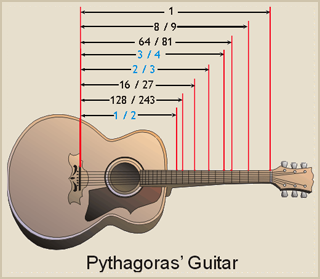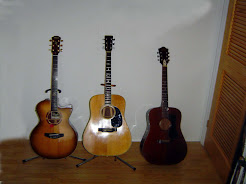The Origin of Music
(Short and Sweet)
(Short and Sweet)
The origin of music is somewhat speculative at best, due to the original creators, being on the razor’s edge of self awareness, having no reason to document their activities for future readers. We can only guess as to how music was created in the primitive psyche of the time. What follows is pretty much my guess.
Early man most likely took some interest in the sounds around him, in some cases it meant life or death, as in the roar of a tiger, or it was pleasing to the ear, as in a bird singing away. I can imagine that after a successful hunt, the hunters would prance and growl around a fire emulating the sounds of the fierce beast they had just slain. They might even have started hitting sticks together in an attempt to emulate the sounds of their clubs thumping dully upon the head of some prey, or the hollow melon sound of a neighbor’s skull when they were fighting amongst themselves over some chunk of meat, or for the best looking mate. The former most likely, due to the fact that the latter would be a six of one half dozen of the other proposition, cosmetics having yet to be invented.
In any case, as far as the origin of music is concerned, drums were probably the first primitive music instrument if we remove the human voice from the equation.
The Encyclopedia Britannica states "Drums appear with wide geographic distribution in archaeological excavations from Neolithic times onward; one excavated in Moravia is dated at 6000 BC. Early drums consisted of a section of hollowed tree trunk covered at one end with reptile or fish skin and were struck with the hands. Later, the skin was taken from hunted game or cattle, and sticks were used. The double-headed drum came later, as did pottery drums in various shapes”. Basically “Bangin' on the bongos like a chimpanzee” was probably our first artistic expression in the realm of music.
The next logical step up from percussion instruments may have been in the woodwind or string family. Imagine a primitive man fascinated by the sound of the wind blowing over some hollow reed, then recreating the effect for his fellow villagers at the next log bashing party, what a hit he would have been! Regular life of the party, such as it was.
Panpipes would have been an easy progression for the primitive mind of the time, stick a bunch of varying length reeds together and voila, let the good times roll. The move from the panpipe to the flute must have taken a much greater leap of faith for the period, yet wooden and bone flutes discovered in china have been dated as far back as 9,000 years ago, and one bone flute made from mammoth bone dates back 35,000 years and has a 4 note scale comparable to the Do, Re, Mi, Fa, scale that was so adamantly drummed into our little grade school heads.
So some concept of a musical scale existed even if the designer merely chose sounds that were pleasing to him. Still the jump from blowing over a hollow reed to blowing down a tube with graduated fingering holes was a large one.
The string section most likely started when some brave soul realized that the sinews garnered from the animals they hunted had uses beyond the traditional binding and stitching functions. From the simple, primitive musical “twang” of a string stretched on a bow as in the Brazilian “berimbau” to the myriad of complex stringed instruments in use today, from violins, to guitars, to pianos, and the many cultural variations thereof.
Pythagoras was credited with the mathematics of music as we know it today. His followers “The Pythagoreans” were all musicians as well as mathematicians. According to legend, Pythagoras discovered that musical notes could be translated into mathematical equations when passing blacksmiths at work, and thought that the sounds of their anvils being hit were harmonious and decided that the scientific law causing this to happen must be mathematical and could be applied to music. He went to the blacksmiths and discovered that the anvils were simple ratios of each other, one was half the size of the first, another was 2/3 the size, and so on. The music of the time being un-harmonious in his opinion, (probably due to instrument makers using scale pleasing to them with no regard for what others were doing). The legend also has Pythagoras studying the vibrations of a string stretched tightly between two posts, and basing his musical scale on the frequency of the vibration when the string length was changed.
When you attach a string between two posts and pull it tight, you can create sound or musical notes by plucking on the string. The vibration of the string will create a fundamental frequency, according to the length, tension and mass of the string. The string can also vibrate at multiples of its fundamental frequency. These are called harmonics.
If the dimensions of the string or wire are correct, the sound made from plucking the string will be a pleasant musical sound, if they are slightly different, the sound may not be musical and just be a sound. In most cases, the string will vibrate at the fundamental frequency or 1st harmonic. But if you pull the string harder, it can be made to vibrate with a shorter wavelength and higher frequency or the 2nd harmonic, 3rd harmonic or even higher.
Pythagoras and his school did experiments to discover the relations between musical notes. The pitch of a note being played on, say, a guitar depends on:
-The length of the string .
-The tension of the string.
Pressing the finger onto the string clamps the string onto the metal fret to the left of where the finger is pressed. The effective length of the string become the distance between the fret and the bridge on the left hand side. If we say the length of the string is one in some system of units, we show the effective lengths of the string for each of the notes in the scale. These harmonious "consonant" lengths were discovered by Pythagoras.
Check Out The new website At http://www.acesandeighths.com. Nice site for a variety of music resources. Everything from Music Theory, History Of Music Genres, History and Construction Of Musical Instruments, Musicians Homepages and Bios, To Music Related Articles.







No comments:
Post a Comment